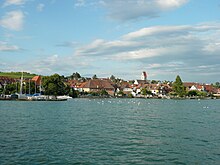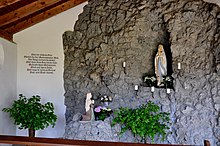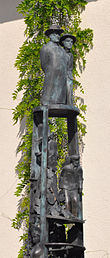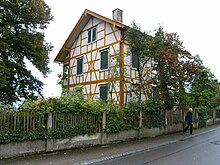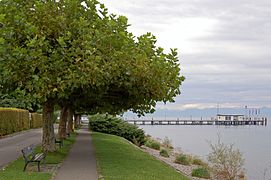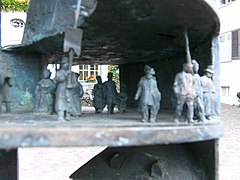Hagnau on Lake Constance
| coat of arms | Germany map | |
|---|---|---|

|
Coordinates: 47 ° 41 ′ N , 9 ° 19 ′ E |
|
| Basic data | ||
| State : | Baden-Württemberg | |
| Administrative region : | Tübingen | |
| County : | Lake Constance district | |
| Height : | 393 m above sea level NHN | |
| Area : | 2.94 km 2 | |
| Residents: | 1409 (Dec. 31, 2018) | |
| Population density : | 479 inhabitants per km 2 | |
| Postal code : | 88709 | |
| Area code : | 07532 | |
| License plate : | FN, TT, ÜB | |
| Community key : | 08 4 35 018 | |
| Address of the municipal administration: |
In Hof 5 88709 Hagnau am Bodensee |
|
| Website : | ||
| Mayor : | Volker Frede (independent) | |
| Location of the municipality of Hagnau on Lake Constance in the Lake Constance district | ||
Hagnau am Bodensee is a municipality in the Lake Constance district in Baden-Württemberg . At the beginning of the 19th century it was still called Hangnau .
geography
Hagnau is located on the north shore of Lake Constance between Meersburg and Friedrichshafen on a steep hillside.
Above the village is the Wilhelmshöhe hill (473 m), a popular vantage point.
history
Already during the late Bronze Age 1050 BC. The lakeside settlement of Hagnau-Burg was inhabited. In 1986 the oldest wooden flute in Europe was found here . In the Überlinger Museum there is a Roman oil lamp that was found in Hagnau.
At the end of the 6th / beginning of the 7th century, Hagnau belonged to the territory of the Alemanni Duke Gunzo . In 1010 the Guelphs donated the area to the Benedictine Abbey of Altdorf . Hagnau was first mentioned on January 24, 1152 in a document by Pope Eugen III. mentioned. In 1436 the Weingartner abbot sold Hagnau to Überlingen. The plague called for in 1514 in almost every home in Hagnau dead. In 1650 Hagnau was sold by Überlingen to the Einsiedeln monastery . Einsiedeln sold Hagnau in 1693 to the Benedictine abbey Weingarten . Then it was secularized in 1803, and Hagnau became Baden.
In 1817 there was a great famine in Hagnau. The flooding of Lake Constance flooded the cellars and the streets of the lower village of Hagnau at foot high. In 1830 there was a sea frost and the people of Hagnau carried the bust of St. John of Münsterlingen to Hagnau in the ice procession . In 1880 there was another Seegfrörne without an ice procession (it did not appear again until 1963, and the bust of Johannes was brought back to Münsterlingen). In 1882 the level of Lake Constance sank so much that the rock "Die Burg" lay dry. In the autumn of 1891 the floods of Lake Constance flooded the lower village again.
A war memorial with the names of the fallen and missing on the south side of the parish church commemorates the time of the First and Second World War.
On January 1, 1973 the district of Überlingen was dissolved, whereby Hagnau came to the newly formed Lake Constance district.
politics
Administrative association
Hagnau has merged with the city of Meersburg and the municipalities of Daisendorf , Stetten and Uhldingen-Mühlhofen to form a municipal administration association.
mayor
In October 2015, the lawyer Volker Frede was elected to succeed Simon Blümcke in the first ballot. Frede took office on December 15, 2015.
Municipal council
The following distribution of seats resulted in the local elections on May 25, 2014. The turnout was 69.0% (2009: 68.9%).
- Free voters - 44.9%, 5 seats (+1)
- CDU - 31.8%, 3 seats (=)
- Hagnau Aktiv - 23.3%, 2 seats (−1)
coat of arms
Blazon : In a split shield in front a golden crook in blue, behind in silver a blue grape with two green leaves.
The crosier is a reference to the long spiritual rule over the place. The branch with the blue grape represents the viniculture in Hagnau, which is still intensively practiced today. The coat of arms was awarded to the community by the Baden-Württemberg Minister of the Interior on July 2, 1963.
Community partnerships
Hagnau maintains partnership relationships with the three Swiss municipalities across from the southern shore of Lake Constance :
- Altnau : The bond between Altnau and Hagnau was always evident when the lake was frozen over and could be crossed. The exploration of the passability of Lake Constance in preparation for the ice procession led the Hagnau residents to Altnau in 1880 (“warmly received by the Altnauers”) and in 1963 in the first group to Güttingen (“when the innkeepers 'Zum Schiff' in Güttingen took us to their warm room ") And in the second group to Altnau (" then turned south directly towards the small port of Altnau "). On February 6, 1830, 100 Hagnau school children brought a framed picture of Christ across the frozen lake to the school in Altnau. This picture was brought back to the Hagnau School on February 9, 1963 by 60 pupils from the Altnau secondary school across the frozen lake. On Wednesdays, Fridays and Sundays there is a direct boat connection (lake line) from Altnau across Lake Constance to Hagnau and Immenstaad.
- Münsterlingen : The partnership is particularly strengthened by the custom of picking up the bust of St. John over the frozen lake from the partner community to one's own community during the so-called Seegfrörne . The custom of the ice procession has existed since the Seegfrörne of 1573. An inscription on the boulder from 1830 in the green area at the ship landing stage in Hagnau reminds of the crossing of the lake by Hagnau citizens in February 1880 (without the ice procession) on the occasion of the Seegfrörne at the Osthafen below the town hall is a reminder of the Seegfrörne and ice procession of 1963. Since then, the bust of John has been in the parish church of the former Münsterlingen monastery again , and the base in the Hagnau church is empty.
- Güttingen
Economy and Infrastructure
Viticulture
Hagnau's history is inextricably linked with viticulture. The place is known for its extensive wine-growing areas. The winegrowers' cooperative , the Winzerverein Hagnau eG, is the oldest in Baden and the largest on Lake Constance, both in terms of members (97 winegrowers from 50 wine-growing families) and hectares of vineyards (150 hectares of cultivation area). In the meantime, many winegrowers have created a second mainstay with tourism. The winegrowers' association was founded in 1881 by the folk writer and pastor of the community, Heinrich Hansjakob , in times of economic hardship. Viticulture is operated in a "controlled, environmentally friendly" manner and with reduced yield.
Fruit growing
Lake Constance fruit (apples and plums) is grown in the higher hinterland. There are 40 small burners in the municipality of Hagnau (as of December 2011).
fishing
Fresh or smoked Lake Constance fish , such as whitefish , can be bought at several points along Seestraße and further down the road . The restaurants offer freshly caught whitefish from Lake Constance. There are a total of five fishermen in the village with the typical open, shallow fishing boats.
tourism
An intact village structure, the direct location on Lake Constance and walking paths on Lake Constance to Immenstaad and Meersburg make Hagnau a popular holiday destination.
traffic
The village is on federal highway 31 , about 13 kilometers west of Friedrichshafen. It can be reached every half hour during the day by train bus on the Friedrichshafen – Immenstaad – Hagnau – Meersburg– Überlingen route in the Bodensee-Oberschwaben transport association ( bodo ). The nearest train stations for long-distance traffic are in Friedrichshafen and Konstanz, the nearest airport in Friedrichshafen. Hagnau can also be reached several times a day by ship ( Konstanz - Bregenz line of the Bodensee-Schiffsbetriebe ). The Lake Constance circular route and the Lake Constance cycle route lead through Hagnau.
freetime and sports
- To the east of the village there is a natural beach with bathing facilities and sanitary and changing areas.
- There is also a natural campsite right on the lake to the east of the village.
- At the ship landing stage (Westhafen) there is a boat rental with pedal boats and motor boats.
- For hikers there are 45 kilometers of circular hiking trails marked with a grape symbol.
- Tennis courts are located at the town hall and at the TC Hagnau.
- There is a mini golf course across from the lakeshore.
Culture and sights
Buildings
The parish church of St. Johann Baptist includes the most important styles of the last eight centuries: the tower is Romanesque, the choir Gothic, the nave Baroque - and the original painting of the ceiling and the choir arch is from 1980. In the churchyard is a chapel with a statue of the St. Wendelin and one with a replica of the Lourdes grotto.
There are still six former monastery courtyards from the time of the monastery .
- One of these is the Salmannsweiler Hof, which was rebuilt in 1568, belonging to the Salem Imperial Abbey ( Hagenau Castle ).
- The former cloister courtyard (Hofmeisterei) of the Benedictine monastery Weingarten from 1714 was a farm for the land in Hagnau and the surrounding area. It comprised 30 rooms, attic storage and two large cellars. The builder was Abbot and Landlord Sebastian Hiller (1697–1730). The construction manager was Frater Andreas Schreck from Vorarlberg. The monastery courtyard is built in Baroque style on a hillside and parallel to the lake shore. In 1806, after secularization, it passed into Baden state ownership and was sold to the municipality of Hagnau in 1846. The building housed the town hall. The building cellar has been used by the Hagnau winegrowers' association since 1882 . Today the building houses the citizens' and guest house and the Hagnauer Museum.
- The Irseer farm was built in the 18th century and served as the official home of the Benedictines - Monastery Irsee in Kaufbeuren . Today it is used as a residential building.
- The former tithe house of the Diocese of Constance was built in 1680 under Bishop Franz Johann Prassberg.
- The former office building of Einsiedeln Monastery (1650–1693) and the Reichsabbey Weingarten (1693–1803), today the Gasthaus zum Löwen.
- The Schussenrieder Hof from 1742, which was used by the Premonstratensian imperial abbey in Schussenried .
Snowball pillar
This metal sculpture on a stone base is in the center of the village. It is composed of small figures and was created by the sculptor Gerold Jäggle . It depicts scenes that Hansjakob captured in his book Snow Balls from Lake Constance via Hagnau. The top of the sculpture is dedicated to Hansjakob and his sacristan. In the levels below, residents, traditional costumes, buildings and squares, fishermen and the ice procession at the Seegfrörne are shown.
Riverside park in Hagnau
The riverside park is bordered by the streets Im Hof, Strandweg and the shore of Lake Constance. The part of the park below the town hall is laid out with southern flora. In the Uferpark are the Alte Torkel, the three trees for the unity of Germany, another monument for Hansjakob and the Osthafen.
Hagnau costumes
Long-established Hagnau women wear their traditional costumes with the filigree, gold-colored costume hood on public holidays or celebrations.
Museums
In the Hagnau Museum in the town hall of Hagnau there are stone tools and Bronze Age collections from the pile dwellings in Hagnau, a documentation on the Seegfrörne from 1573 to 1963, a compilation of the life and work of Heinrich Hansjakob, ink pictures by the painter Julius Heinrich Bissier and paintings by the Hagnau painter Reinhard Sebastian Zimmermann . The museum is funded by the German literature archive in Marbach.
The oldest wooden flute in Europe from Hagnau-Burg (1050 BC) is exhibited in the Pfahlbaumuseum Unteruhldingen .
With the small museum , Hagnau has another museum. The private collection includes dolls, dollhouses, kitchens, shops and other toys from 1830 to 1920.
Regular events
The spring festival is celebrated at the beginning of May. The Fountain Festival is celebrated on Ascension Day. It commemorates the inauguration of the owl fountain by the Eule jester association at the end of the 20th century. At the end of May, the Häfelefest will follow right on the lake. The Wimmler, Summer and Hagnau Wine Festivals follow in June, July and August. The festival ends with the harvest festival and parish festival and the Suser festival in October.
There is also the regular weekly program of events for tourists during the summer season (wine tastings, walks, slide shows, astronomical tours, spa concerts and the Sunday concert).
Personalities
sons and daughters of the town
- Johann Jakob Steffelin (1754–1838), lawyer, Oberamtmann of Württemberg
- Reinhard Sebastian Zimmermann (1815–1893), painter. His retirement home, the so-called painter's house from 1878, is located on Seestrasse and is still preserved.
Citizen
A prominent resident of Hagnau was the teller and civil rights activist Heinrich Hansjakob (1837-1916), who was parish priest here from 1869 and on October 20, 1881 founded the Hagnau winegrowers' association. A memorial plaque on the former house, the life-size monument to Hansjakob with the typical Hecker hat on the north side and a memorial stone on the south side of the town hall remind of his achievements.
The artist Julius Bissier moved with his wife Lisbeth Bissier from Freiburg im Breisgau to Hagnau in 1939 . There he developed his unique visual and formal language. In 1961 he moved to Ascona , Switzerland, where he died in 1965.
All of the personalities named here will be honored and presented in the newly designed (2010) Hagnauer Museum.
Web links
Statue of Heinrich Hansjakob by Peter Lenk on the private grounds of the Burgunderhof in Hagnau. Can be seen from the public street Am Sonnenbühl
Bust of Saint John
Individual evidence
- ↑ State Statistical Office Baden-Württemberg - Population by nationality and gender on December 31, 2018 (CSV file) ( help on this ).
- ↑ Kompass (Ed.): Lexikon Bodensee Gesamtgebiet , 1c, ISBN 3-85491-002-9 , p. 20
- ↑ Günter S. Schöbel: A flute fragment from the Late Bronze Age settlement of Hagnau-Burg, Lake Constance district . In: Archaeological News from Baden . Issue 38/39, 1987, pp. 84-87.
- ↑ See: Karl Heinz Burmeister. Lake Constance in the 16th century. Montfort, quarterly magazine for the past and present of Vorarlberg. Year 2005, Issue 3. Page 243. pdf ( Memento of the original from January 31, 2012 in the Internet Archive ) Info: The archive link has been inserted automatically and has not yet been checked. Please check the original and archive link according to the instructions and then remove this notice.
- ↑ Gertraud Gaßner, Rainald Schwarz-Gaßner: Rad travel book. Around Lake Constance . Knaur Taschenbücher 4635. ISBN 3-426-04636-9 . P. 234
- ↑ Sylvia Floetemeyer: church history under vines. In: Südkurier from February 15, 2003. ( Memento of the original from March 10, 2014 in the Internet Archive ) Info: The archive link was inserted automatically and has not yet been checked. Please check the original and archive link according to the instructions and then remove this notice.
- ^ Heinrich Hansjakob: Schneeballen, third row , 1893. New edition 1911 in the publishing house of Adolf Bonz & Comp. Stuttgart. New edition in 2002 by the Waldkircher Verlagsgesellschaft, Waldkirch, ISBN 3-87885-190-1 . Pp. 164–172, 181, 280. (Events during the time as pastor of Hagnau 1869-1884).
- ↑ Fallen memorials: Fallen and missing in Hagnau
- ↑ https://www.google.de/webhp?sourceid=chrome-instant&ion=1&espv=2&ie=UTF-8#q=volker+frede+hagnau+wahl
- ^ Friedrich Meichle: Seegfrörne and ice procession in the past and present . In: Writings of the Association for the History of Lake Constance and its Surroundings . No. 81 . Thorbecke, Lindau / Konstanz 1963, p. 155,159,161,162 ( online ). Online ( Memento of the original from September 16, 2016 in the Internet Archive ) Info: The archive link was inserted automatically and has not yet been checked. Please check the original and archive link according to the instructions and then remove this notice.
- ↑ From Hagnau to the Swiss. In: Südkurier, Markdorf edition of June 4, 2011, p. 36
- ↑ Kompass (Ed.): Lexikon Bodensee Gesamtgebiet , 1c, ISBN 3-85491-002-9 , p. 21
- ^ Friedrich Meichle: Seegfrörne and ice procession in the past and present . In: Writings of the Association for the History of Lake Constance and its Surroundings . No. 81 . Thorbecke, Lindau / Konstanz 1963, p. 145-170 ( online ). Online ( Memento of the original from September 16, 2016 in the Internet Archive ) Info: The archive link was inserted automatically and has not yet been checked. Please check the original and archive link according to the instructions and then remove this notice.
- ^ Südkurier-Grafik: Orlowski / Source: Hauptzollamt Ulm: Number of small burners . In: Hanspeter Walter (hpw): The old monopoly is running out . In: Südkurier of December 17, 2011
- ↑ Information board at the town hall
- ^ Hagnauer Museum (Ed.): Hagnauer Museum in the citizen and guest house. Leaflet from around 2012
- ↑ Diethard Hubatsch: 300 years of Hofmeisterei of Weingarten Monastery. In: Kreisarchiv Bodenseekreis (Ed.): Open Monument Day on September 14, 2014. Leaflet Salem 2014.
- ^ District archive Bodenseekreis (ed.): Historical places of enjoyment in the Bodenseekreis. Open Monument Day September 13, 2009.
- ↑ Nice nooks and crannies on the Hagnau website
- ↑ Hagnau's beautiful nooks and crannies. Die Schneeballensäule In: Event calendar Hagnau, July 2012, p. 1
- ↑ Website of the Hagnauer Museum ( Memento of the original from October 1, 2010 in the Internet Archive ) Info: The archive link has been inserted automatically and has not yet been checked. Please check the original and archive link according to the instructions and then remove this notice.
- ↑ Wine and a good mood. In: Südkurier, Markdorf edition of June 4, 2011, p. 36
- ^ Heinrich Hansjakob: Schneeballen, third row , 1893. New edition 1911 in the publishing house of Adolf Bonz & Comp. Stuttgart. New edition in 2002 by the Waldkircher Verlagsgesellschaft, Waldkirch, ISBN 3-87885-190-1 . P. 111. (Events during the time as pastor of Hagnau 1869-1884).




